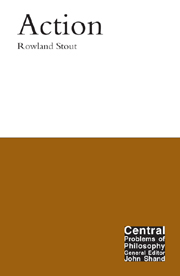Book contents
- Frontmatter
- Contents
- Acknowledgements
- 1 Introduction: inward-looking and outward-looking approaches to agency
- 2 Acting for a reason
- 3 Reasons and passions
- 4 Agent causation
- 5 Mental causation
- 6 Deviant causal chains and causal processes
- 7 Acting with an intention
- 8 Prior intention
- 9 The metaphysics of action
- Conclusion
- Notes
- Suggestions for further reading
- References
- Index
8 - Prior intention
- Frontmatter
- Contents
- Acknowledgements
- 1 Introduction: inward-looking and outward-looking approaches to agency
- 2 Acting for a reason
- 3 Reasons and passions
- 4 Agent causation
- 5 Mental causation
- 6 Deviant causal chains and causal processes
- 7 Acting with an intention
- 8 Prior intention
- 9 The metaphysics of action
- Conclusion
- Notes
- Suggestions for further reading
- References
- Index
Summary
Davidson's later theory of intending
Davidson changed his mind about intentions between the time of his earlier article, “Actions, Reasons and Causes” and the slightly later one, “Intending” (1980: essay 5). In his earlier article he was keen to avoid what I have described as an inward-looking approach, and thought that the way to do this was to treat acting with an intention as the primary notion. His unstated presumption was that prior intentions might be understandable in terms of acting with an intention. His idea in the first article was that acting with an intention was having a reason for acting in a certain way that caused one to act in that way. He took the reason to be the combination of a relevant belief – namely, that this action is such and such a kind of action – and a relevant desire or other positive attitude towards actions of such and such a kind. He thought that there was no further state, act or disposition that was referred to by the phrase “the agent's intention”; the phrase was syncategorematic
Whatever the merits or otherwise of this approach to acting with an intention, it certainly cannot be applied directly to prior intentions (what Davidson called “pure” intentions). You can have a prior intention to do something without being caused to do it; the intention may never be realized in action. Once the causal aspect of his original theory is removed, what is left in Davidson's account of having an intention is just that the agent has a reason to act in that way.
- Type
- Chapter
- Information
- Action , pp. 119 - 136Publisher: Acumen PublishingPrint publication year: 2005

